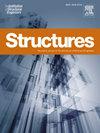Fracture mechanics-based meshless method for crack propagation in concrete structures
IF 4.3
2区 工程技术
Q1 ENGINEERING, CIVIL
引用次数: 0
Abstract
Concrete is one of the most versatile construction materials, characterized by its high compressive strength and durability. It exhibits complex fracture behaviours in the non-linear region of the fracture process zone (FPZ) near crack tip, where micro-cracking, crack coalescence, and eventual macro-crack propagation occurs. Accurately predicting crack initiation and propagation in concrete structures is essential for ensuring their safety and performance. Traditional methods like finite element analysis (FEM) face challenges in capturing crack propagation due to the need for mesh refinement, which can be computationally expensive. This study aims to address this limitation by introducing the Element-Free Galerkin (EFG) method, which offers a more efficient approach for modelling crack behaviour in concrete beams. The maximum stress theory was used as the fracture criterion and the cohesive zone model (CZM) with a bilinear softening curve is employed to simulate the FPZ. Numerical examples of simply supported beam and cantilever beams with varying pre-notch positions and loadings were analysed. The results show that under axial and point loading, the stress intensity factor increases with crack length until unstable crack growth, leading to failure. The EFG method is found to be more accurate than FEM, particularly in regions with higher deformations, with a 13 % variation due to remeshing in FEM. Under point loading, EFG predicted deformation patterns with a 6 % variation in maximum deflection. This study demonstrates that the EFG-based model effectively predicts catastrophic failures, offering a computationally efficient solution for real-world concrete structures with pre-existing cracks or defects.
基于断裂力学的混凝土结构裂缝扩展无网格方法
混凝土是最通用的建筑材料之一,其特点是具有高抗压强度和耐久性。在靠近裂纹尖端的断裂过程区(FPZ)的非线性区域表现出复杂的断裂行为,在这里发生微裂纹、裂纹合并和最终的宏观裂纹扩展。准确预测混凝土结构裂缝的起裂和扩展对保证混凝土结构的安全和性能至关重要。传统方法如有限元分析(FEM)在捕获裂纹扩展方面面临挑战,因为需要网格细化,这可能是计算昂贵的。本研究旨在通过引入无单元伽辽金(EFG)方法来解决这一限制,该方法为混凝土梁的裂缝行为建模提供了更有效的方法。采用最大应力理论作为断裂准则,采用双线性软化曲线黏结区模型(CZM)对弹性弹性区进行模拟。分析了具有不同预缺口位置和载荷的简支梁和悬臂梁的数值算例。结果表明:在轴向载荷和点载荷作用下,应力强度因子随裂纹长度的增大而增大,直至裂纹扩展不稳定而导致破坏;发现EFG方法比FEM更准确,特别是在变形较高的区域,由于FEM中的重网格,其变化率为13 %。在点加载下,EFG预测的变形模式与6 %的最大挠度变化。该研究表明,基于eeg的模型有效地预测了灾难性破坏,为具有预先存在裂缝或缺陷的现实混凝土结构提供了计算效率高的解决方案。
本文章由计算机程序翻译,如有差异,请以英文原文为准。
求助全文
约1分钟内获得全文
求助全文
来源期刊

Structures
Engineering-Architecture
CiteScore
5.70
自引率
17.10%
发文量
1187
期刊介绍:
Structures aims to publish internationally-leading research across the full breadth of structural engineering. Papers for Structures are particularly welcome in which high-quality research will benefit from wide readership of academics and practitioners such that not only high citation rates but also tangible industrial-related pathways to impact are achieved.
 求助内容:
求助内容: 应助结果提醒方式:
应助结果提醒方式:


